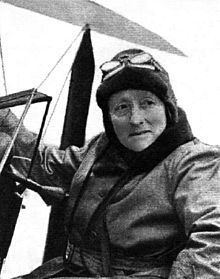Name Mary Duchess Role Aviator | Died March 22, 1937 | |
 | ||
Children Hastings Russell, 12th Duke of Bedford Grandchildren Ian Russell, 13th Duke of Bedford, Lord Hugh Hastings Russell, Lady Daphne Crommelin Russell Great grandchildren Robin Russell, 14th Duke of Bedford, Lord Francis Hastings Russell, Lord Rudolf Russel People also search for Herbrand Russell, 11th Duke of Bedford | ||
Mary Russell, Duchess of Bedford (26 September 1865 – ca. 22 March 1937) was an English aviator and ornithologist. She was honoured for her work in founding hospitals and working in them during the first world war. She later financed and took part in record breaking flights to Karachi and Cape Town.
Contents
Early and personal life
Born as Mary Du Caurroy Tribe at Stockbridge, Hampshire, she was the daughter of Walter Harry Tribe, Anglican Archdeacon of Lahore. On 31 January 1888, she married Lord Herbrand Russell at Barrackpore, India. When Lord Herbrand inherited his childless brother's titles in 1893, she was styled as the Duchess of Bedford. Her only child, Hastings, was born on 21 December 1888.
Work and activism
A major area of organisation and work for the Duchess was in founding four hospitals in Woburn and in the grounds of Woburn Abbey. The principal establishment was the Abbey Hospital that she financed and built in 1914, and where she worked as a nurse and radiographer through to the 1930s.
The Duchess was a collector and watcher of birds, and took an interest in bird migration. Between 1909 and 1914 she spent much time on Fair Isle, often in the company of William Eagle Clarke. Her journal, A Bird-watcher's Diary, was privately published in 1938 after her death.
She was a member of the Women's Tax Resistance League, a group associated with the Women’s Social and Political Union that used tax resistance to protest the disenfranchisement of women during the British women's suffrage movement.
Aviation
Late in life at age 63, the Duchess became interested in aviation, that she claimed gave her some relief from her constant tinnitus, although she eventually became totally deaf. On 2 August 1929, she departed on a record-breaking flight of 10,000 miles from Lympne Airport to Karachi (then in India) and return to Croydon Airport in eight days. She was accompanied in her single-engined Fokker F.VII (G-EBTS, Princess Xenia, which she renamed "The Spider" for its tenacity) by her personal pilot Captain C. D. Barnard and mechanic Robert (Bob) Little. On 8 April 1930 she made her first solo flight, in her DH.60G Moth (G-AAAO). On 10 April 1930 she embarked on a record-breaking flight from Lympne Airport to Cape Town, in "The Spider", flying 9,000 miles in 91 hours and twenty minutes over 10 days, again with Barnard and Little.
In 1934 and again in 1935, with co-pilot F/Lt R. C. Preston in de Havilland Puss Moth G-ABOC, the Duchess made extensive flights from England to the Western Sahara and Northern Nigeria.
Honours
In January 1918 the duchess was awarded the Royal Red Cross in the second Associate grade, for her services to wartime nursing at Woburn Auxiliary Hospital. She was appointed a Dame Commander of the Order of the British Empire in 1928. She was also Dame of Grace of the Order of Saint John (DGStJ) and a Fellow of the Linnean Society of the Imperial College (FLS).
Death
The duchess died aged 71, in March 1937, three months before Amelia Earhart's death, after leaving Woburn Abbey in a DH.60GIII Moth Major (G-ACUR), that crashed into the North Sea off Great Yarmouth; her body was never recovered.
